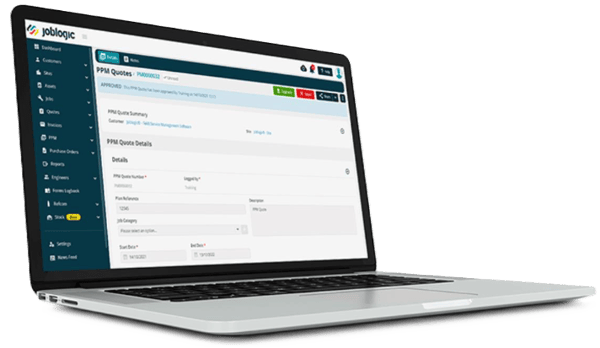Setting up planned preventive maintenance contracts is one of the most time-consuming activities carried out by building services companies. It involves the collection of lots of data which then needs to be carefully planned into a schedule to ensure compliance. Engineering resources need to be considered to make sure that the work can be done without compromising other work such as reactive calls and projects. The outcome of the work then needs to be reported back to the client for invoices and payment to be approved. Joblogic’s preventive maintenance software can help to manage this process efficiently, saving time and money.
Our partners

Book your free planned maintenance software demo today!
Speak to our product expert to see how the Joblogic features fit your business
*No hard sell, no commitment
Our valued customers
Frequently asked questions about planned maintenance software
Planned maintenance software (aka preventive maintenance software) is dedicated to helping maintenance teams manage their maintenance activities and improve the performance of assets for which they are responsible. It helps assign jobs to engineers, manage tasks, and keep track of work.
Planned and preventative maintenance software should possess several features. This contains software modules that allow the user to:
Asset management modules: This allows you to track the history of asset repairs.
Job Management modules: Give you the ability to assign and monitor jobs to engineers when they're on-site.
Your back office and maintenance teams will benefit from planned maintenance software. These include:
- Improved asset reliability and reduced asset downtime
- Longer lifespans for equipment
- Optimised job scheduling that allows you to get more done every day
- The ability to manage your inventory and stock across multiple locations
- Easier regulatory compliance
- Automated tasks that allow for less time to be spent on repetitive tasks
Planned Maintenance Software (PMS) offers several cost-saving benefits:
- Minimised Downtime: By identifying and resolving potential equipment issues before they become significant problems, PMS reduces unexpected downtime, ensuring smooth operations and preventing productivity losses.
- Increased Asset Longevity: Regular maintenance facilitated by PMS ensures equipment operates efficiently and lasts longer, resulting in fewer replacements and lower overall equipment costs.
- Enhanced Inventory Management: PMS tracks spare parts and inventory levels, ensuring the availability of necessary parts for maintenance tasks. This prevents emergency purchases and reduces the risk of stockouts.
- Efficient Resource Allocation: PMS optimises the scheduling of maintenance tasks, assigns the right technicians to the appropriate jobs with the necessary tools, and reduces wasted time and labour costs.
- Data-Driven Insights: PMS collects valuable data on equipment performance and maintenance history, allowing you to identify areas for improvement, optimise maintenance schedules, and make informed decisions about future equipment investments.
Overall, PMS promotes a proactive approach to equipment care, leading to significant long-term cost reductions.
Planned Maintenance Software (PMS) enhances operational efficiency in several key ways:
- Proactive Maintenance: PMS enables proactive identification and resolution of potential equipment issues before they escalate into significant failures, reducing unexpected downtime and ensuring smooth operations.
- Optimised Maintenance Scheduling: PMS assists in planning and scheduling maintenance tasks efficiently, ensuring that maintenance is performed at optimal times to minimise disruption to operations.
- Effective Resource Allocation: By assigning the right technicians to the appropriate jobs with the necessary tools, PMS ensures that maintenance tasks are performed efficiently, reducing wasted time and labour costs.
- Streamlined Communication: PMS facilitates better communication and coordination among maintenance teams, ensuring everyone knows their tasks and any updates or changes in real-time.
- Comprehensive Record Keeping: PMS maintains detailed records of maintenance activities, equipment performance, and repair histories, allowing for quick reference and better management of maintenance tasks.
- Inventory Management: PMS tracks spare parts and inventory levels, ensuring that necessary parts are available, thus avoiding delays in maintenance tasks due to stockouts.
- Data-Driven Decisions: PMS collects and analyses data on equipment performance and maintenance activities, providing insights that help optimise maintenance schedules and improve overall operational efficiency.
By implementing PMS, organisations can streamline their maintenance processes, reduce downtime, and enhance the overall efficiency of their operations.
Joblogic is an all-in-one system, which means you can simplify your technology stack by using it without worrying about integrating it with other systems.
Planned Maintenance Software (PMS) significantly enhances safety and compliance in several ways:
Regular Safety Inspections: PMS ensures that safety inspections are scheduled and conducted regularly. This helps identify and address potential safety hazards before they cause accidents or injuries.
Compliance with Regulations: PMS helps organisations stay compliant with industry regulations and standards by ensuring that all maintenance activities meet the required guidelines. This reduces the risk of non-compliance penalties and legal issues.
Automated Documentation: PMS maintains detailed records of all maintenance activities, inspections, and repairs. This documentation is crucial for demonstrating compliance during audits and inspections by regulatory bodies.
Timely Updates and Alerts: PMS provides timely alerts and notifications for scheduled maintenance, inspections, and regulatory updates. This ensures every critical task is noticed, maintaining continuous compliance and safety.
Improved Equipment Reliability: By ensuring regular and thorough maintenance, PMS reduces the likelihood of equipment failures that could pose safety risks. Reliable equipment contributes to a safer working environment.
Training and Certification Tracking: PMS can track maintenance personnel's training and certification status, ensuring that only qualified technicians perform specific tasks. This reduces the risk of errors and enhances overall safety.
Risk Assessment and Mitigation: PMS facilitates regular risk assessments and the implementation of mitigation strategies. By identifying and addressing potential risks proactively, organisations can enhance workplace safety.
Audit Trail: PMS provides a comprehensive audit trail of all maintenance and safety activities, making reviewing and improving safety protocols and compliance measures easier.
By leveraging PMS, organisations can create a safer working environment, ensure compliance with regulations, and reduce the risk of accidents and legal issues.
Yes, Planned Maintenance Software (PMS) suits various industries due to its versatile and adaptable features. The industries that can benefit from PMS include:
- Manufacturing
- Healthcare
- Facilities Management
- Transportation and Logistics
- Energy and Utilities
- Hospitality
- Education
- Retail
- Aviation
- Construction


.png?width=300&height=123&name=BAD_Sales_Image_(1).png)








































